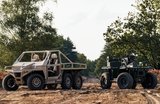SSJ100 in Yakutsk for cold soak trials
The third Sukhoi Superjet 100 flight prototype, SN95004 (pictured at its roll-out), has landed at Yakutsk airport where it will undergo cold soak trials.
These trials are required to examine the ability of the aircraft and its systems to resist temperature shock. The testing aims to validate the standard flight preparation of the aircraft after short (up to 2 hours) and long (no less than 12 hours) parking and to confirm systems performance, including the warming up time, prior to departure. The interior temperature in both the cockpit and the passenger cabin is also a part of the trials.
Overall, the main checks will refer to engine launch procedures, fuel system and environmental system functionality. For this current set of tests it was necessary to employ SSJ100 SN95004, as this aircraft features full crew cockpit interior and passenger service equipment – the interior, a kitchen and a lavatory – representing full certification configuration. The launch and systems operations will be monitored by a tailored onboard control system.
Yakutsk lies in the planet’s coldest inhabited area. The airport there is a traditional place for cold soak trials for Russia’s aeronautics industry. Average February temperature in Yakutsk reaches –35°С.






















